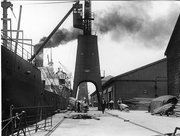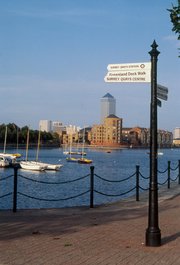Greenland Dock
|
|
Greenland Dock is the oldest of London's riverside docks, located in Rotherhithe in the area of the city now known as Docklands. Now used purely for recreational purposes, it is one of only two working enclosed docks on the south bank of the River Thames.
| Contents |
Howland Great Wet Dock
Howland_gwd_1717.jpg
The dock was originally built around 1698 by the aristocratic Russell family of the Duke of Bedford. The Russells had been given a portion of land in lower Rotherhithe by a wealthy Streatham landowner, John Howland, as part of a wedding dowry for his daughter Elizabeth, who married Wrothesley Russell, the Marquis of Tavistock. They immediately set about "improving" the rural property, obtaining parliamentary permission in 1695 to construct a rectangular dock with an area of about 10 acres (40,000 m²), capable of accommodating around 120 ships. It was named Howland Great Wet Dock in honour of John Howland.
In a picture of about 1717, it can be seen in a rural setting some miles outside the (much smaller) city of London, lined with trees on three sides (to act as windbreaks) and with the Russell family's mansion situated at the western end. Unlike the later docks, it was not built with cargo traffic in mind; it did not have walls, warehouses or other commercial facilities. Instead, it was promoted as being capable of accommodating ships "without the trouble of shifting, mooring or unmooring any in the dock for taking in or out any other". It was essentially a re-fitting base where ships could be repaired and berthed in a sheltered anchorage. It was aided in this regard by its proximity to the dockyards at Deptford
The whaling and timber trades
Howland Great Wet Dock was sold by the fourth Duke of Bedford in 1763. It came to be used by the whaling ships which operated principally in the North Atlantic around Greenland, prompting its renaming to Greenland Dock. For the remainder of the 18th century, it was used to refit whaling ships and as a location for the boiling of blubber to produce oil. However, this trade declined sharply by the start of the 19th century.
In 1806 the dock was sold to William Richie, a Greenwich timber merchant and founder of the Surrey Commercial Dock Company. The Company built a series of additional docks and timber ponds while rival companies built additional docks, leading to the jumble of harbours, canals and timber ponds that collectively made up the Surrey Commercial Docks. Greenland Dock remained at the centre of London's timber trade for well over a century to come. It was lined with warehouses and immense piles of timber or "deal", which were maintained by the athletic deal porters. Much of the timber arrived aboard small sailing vessels from the Baltic region, although these were eventually displaced by large steamers.
Expansion and decline
Between 1895-1904 Greenland Dock was greatly expanded by being extended to the west in a project carried out under Sir John Wolfe-Barry, the engineer who built Tower Bridge. In its final form, it covered an area of 22.5 acres (91,000 m²), with a depth of 31 feet (9 m) and a length of 2,250 feet (690 m), which cut straight across the old Grand Surrey Canal. It was also given a massive lock, 550 feet (170 m) long. This renovation enabled the dock to take large cargo ships and even ocean-going liners. Cunard Line vessels of as much as 14,000 tons sailed regularly from Greenland Dock to destinations in eastern Canada, carrying passengers and cargos in both directions.
In 1909 the dock, along with all of the other London docks, was amalgamated into the Port of London under the management of the Port of London Authority.
Greenland Dock suffered greatly during World War II, when many of the warehouses were razed by German bombing and the great lock was rendered unusable due to bomb damage. It soon recovered after the war and enjoyed a brief resurgence of prosperity. However, technological changes in the shipping industry soon pushed the dock into a spiral of decline. The deal porters' jobs were abolished from 1958 when timber started to be "packaged", or bundled in packaged quantities. Not long afterwards, the shipping industry moved en masse to the system of containerization, which required bulk carriers far too large to be accommodated in the London docks. In 1970, the Surrey Commercial Docks were closed. Greenland Dock was sold to Southwark council.
Redevelopment
The Surrey Docks remained derelict for over a decade, with much of the warehousing demolished and over 90% of the docks filled in. Greenland Dock, which now belonged to the local authority, escaped this fate and in 1981 was handed over to the London Docklands Development Corporation. A masterplan was produced that advocated evicting the remaining industrial occupiers of the quaysides and transforming the dock into a residential area. This went ahead in the late 1980s despite some controversy, with seven residential developments being constructed on the site of the former warehouse complexes (and named after them; hence Swedish Yard became Swedish Quay, Brunwick Yard became Brunswick Quay and so on). Additionally, a watersports centre was constructed on the site of the former entrance to the now infilled Grand Surrey Canal. This has since become a popular site for yachting, windsurfing, canoeing and even Chinese Dragon Boat racing.
The dock itself is still substantially intact, other than its former entrances and exits, all but one of which has been filled in or blocked. It still has a working connection to South Dock, which is now a marina, and has a small marina of its own at its eastern end. There are no traces of the former warehouses, although many of the old capstans and some of the hydraulic machines on the quaysides have been preserved.


